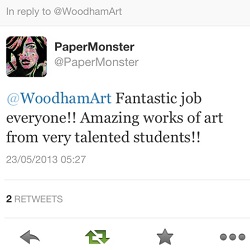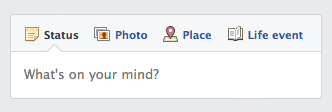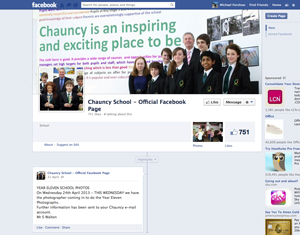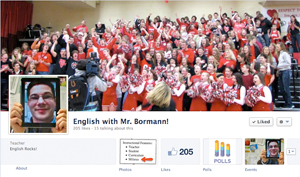
Five years ago, when I first started working with clients on social media, I needed to explain to many of them what it was. Times have changed. Nearly every school now has some kind of presence on social media, but few use it well.
In a nutshell, social media is where your entire school community resides:

There are many potential benefits of using social media in the classroom: it can improve your relationship with pupils, and inspire them to spend more time on their work. Before setting up a Facebook or Twitter account, however, significant preparation is required. Here are my top 5 tips:
This is essential if you are going to convince your school that using social media in education is a good idea. Why do you want to use social media? Is it primarily for teaching and learning, or communicating with students, parents or even the public?
In order to get an idea whether your use of social media has worked you will need to decide what your aims and objectives are, and assess how well these have been met later on. If you’re stuck, do some research on how other schools have used social networks. You could also check educational blogs and ask some questions on Twitter.
Why is social media such a hotly contested topic in schools? There are many ways, as Principal Eric Sheninger explains, in which schools can harness social media and blogging to demonstrate the relevance of learning, and introduce the 'real world' audience to students.

Social Media is bad and has no place in education. It is a distraction to the teaching and learning process. If students are allowed to use social media in school they will stay off task or exhibit inappropriate behavior. Worse, teachers will spend countless hours 'socialising' instead of educating.
This is the misguided stigma that social media carries and, as a result, it is often banned in schools. However, there are a growing number of passionate educators who have embraced social media as a powerful tool for learning. When you look at how reliant the world is when it comes to using social media, these educators look like geniuses.
Photo credit: Jason A. Howie
Teachers can only offer a certain amount of motivation to students, particularly as they are usually the final destination of class and home work. With technology gaining ground in classrooms, however, there is no excuse not to enthuse students with the potential for their work to be shared with the very people that are inspiring their work - authors, artists, scientists, entrepreneurs etc. This is where the benefits of using social media in education really come into play.

After reading 'An Ethic of Excellence' by Ron Berger I was inspired to try and use his core principles to make a difference in my own school.
One of the core principles that struck me from Berger's work was his strong belief that 'to truly engage learners, there needs to be a real audience for their work'. This really rang true for me and took me back to a comment that Julia Skinner made about her fantastic work with the 100 word challenge. During a TeachMeet presentation, Julia asked us all 'how an audience of one person (us, the teacher), can be that motivating'?
If the work always stays on our desk and never goes any further, we are only just scratching the surface in terms of student motivation to do their best. Julia continues to organise a weekly 100 word challenge to engage students in writing, knowing that they'll receive 'real comments' from 'real people' through the power of blogging – hence the increased motivation coming from having a real audience.

In the few decades since the birth of the web we’ve moved from email to social networking to a breadth of online services, storing more and more of our personal information in the so called ‘cloud’.
The level of data out there is growing at an exponential rate. In a typical day last year, people sent more than 144 billion emails, shared more than 684,000 pieces of content on Facebook, and uploaded over 72 hours of video footage onto YouTube every single minute.

When Twitter was first launched back in 2006, many of us were sceptical about whether it would last. What was the point of a tool that only let you send 140-character updates? Why not use Facebook which has a status function plus much more?
Many social journalists never expected it to hit the 5 million mark of users, let alone 500 million. But almost overnight Twitter became an online phenomenon. Today, over 340 million tweets are sent daily from teenagers, worldwide celebrities, small businesses and the largest conglomerates.

Is fear of abuse preventing you from using social media in your school? Are you unsure of what safeguards you can put in place to protect your pupils?
When social media was little more than a tool for socialising, schools could get away with avoiding it. Not any longer. Whether it’s buying a new product, doing business with someone, recruiting a member of staff, or learning a new skill, social media will usually play a part. In fact, social media has become a new form of literacy.
So how do you encourage social media without placing your school at risk?
Here are the steps your school should take before bringing social media into the classroom.

The whole reason for educators to fear Facebook was because "it's unsafe and can't be monitored." Which is partially true, but wasn't convincing enough for me.
Now with 1:1 programs popping up all over, companies like Edmodo, Moodle, and Schoology are developing safe ways for teachers and students to communicate outside of class time. These free online tools are great, but they operate on a more closed basis than Facebook.
However, I don't run my class like that. My class is open, ideas are shared, and if someone goes along the lines of inappropriate, then that's just another opportunity for me to teach.

Over the past few weeks I've been privileged to read so many great blog posts by fellow teachers on the numerous benefits of both tweeting and blogging. Having an online presence in order to collaborate and learn from others is now fast becoming one of the most popular and interesting ways to improve your day to day teaching. More and more teachers are getting involved in this online community, which means there are more and more opportunities to network with like-minded people.
My motivation to write this post was not to re-invent the wheel, but instead to bring together the best posts that have been written on this area. It should be seen as a one-stop guide for both teachers looking to dip their toe in the online teaching community, and also the more experienced 'Tweachers' amongst us.

In today’s teaching world, we are all expected to be “digital natives” and to use all the tools available to enhance teaching and learning. We look to use all sorts of devices to help us communicate, to make life simpler, to be more efficient. We don’t use diaries any more but link our calendar of meetings to our phones or to Outlook. We don’t really need to talk to each other because email, Facebook and Twitter obviate the need for oral communication. We are starting to live in worlds that are hermetically sealed, as our work and social activities become increasingly electronic.
There’s nothing startlingly new in the above paragraph; but with all these new technologies come serious implications for safeguarding. Alarmingly, some teachers are blithely unaware of, or choose to ignore, situations that could cause untold damage to their careers.

A community-driven platform for showcasing the latest innovations and voices in schools
Pioneer House
North Road
Ellesmere Port
CH65 1AD
United Kingdom